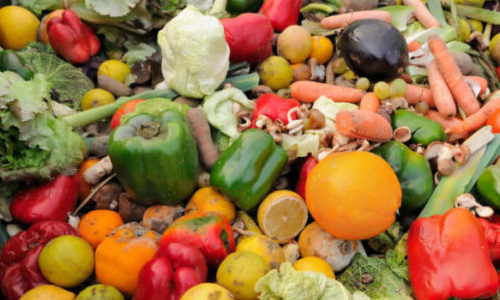
Just the Facts
The numbers may vary but the facts are real. We waste food! It’s estimated we waste between 30 and 40% of the food supply or nearly 40 million tons of food in the United States every year.1

It Starts at Home
Often, we say lessons learned “start at home” and getting a grip on food waste is no different. Here are some basic tips to help us waste less:
- Spring clean the refrigerator and pantry. Over the past year, most of us stocked the shelves, so now it’s time to take an inventory of what you have before purchasing more. Put dates on food and use the foodservice inventory FIFO system (first in, first out) as a guide to not miss expiration dates.
- Buy quantities of fresh produce, dairy or meats with a plan in mind. As farmer’s markets start to open in the Midwest states or other spring offerings open up, resist the temptation to buy more than you or your family can eat in a week or two. (Advice to self!)
- Love your leftovers! My husband and I grew up appreciating the value of leftovers thanks to our mothers’ frugality and the knowledge that our households couldn’t afford to waste food. Frankly, leftovers are viewed as “gold” in our household and inspired creativity. A main entrée on day one becomes tacos or an inspired salad the next day or two. Quantities of soup are divided and frozen for quick meals over the next few months. Leftovers don’t have to be eaten three days in a row but the “rule of thumb”is to freeze the extra portion BEFORE it’s past it’s prime (e.g., in 3-4 days).
- Be realistic about food labels on pantry items. Manufacturers date canned products to help us determine when food is of best quality. With the exception of infant formula, if dates on a canned product that is sitting on your shelf have passed the current calendar year, it should still be safe and good quality if stored properly. Of course, if the can is dented or signs of spoilage are evident, it’s time to toss. Bottom line: don’t stockpile beyond your expected needs!
Food Waste To Food Security
Look around your community and region. For many of us, having access to nutritious food is not the problem, it’s just making the choice. Over the past year, food insecurity has been a reality. In Kentucky, one in six individuals is considered food insecure. That means those individuals experience “unreliable access to a sufficient quantity of affordable, nutritious food.” The reality is food insecurity exists everywhere and will be with us for months to come. In fact, Feeding America provides assistance to one in seven Americans each year.2 Through its network of food banks, the group rescues about 3.6 billion pounds of food. This represents only a small percentage of food that could have been donated, but ended up in a landfill.3

Think About the Environment
We talk about climate change and often think it’s the responsibility of others across the food value chain. But our food waste habits contribute to the reality. Consider these two important facts:
- We use energy to dispose of food waste. When food is wasted, there is additional land, water, labor and energy used in producing, processing, transporting, preparing, storing and disposing of the discarded food.
- Greenhouse gases generated from food waste in landfills could be reduced to help mitigate climate change. Consider this fact: if food waste was a country, It would be the third largest country behind China and the United States in its contribution to greenhouse gas. According the U.S Environmental Protection Agency, food is the single largest category of material placed in municipal landfills, where it emits methane, a powerful greenhouse gas. Municipal solid waste landfills are the third-largest source of human-related methane emissions in the United States, accounting for approximately 14.1% of these emissions in 2017.4
Moving forward in the coming months, we have the opportunity to determine our future. Finding the answers to reduce food waste, food insecurity and environmental issues are in each of our hands. Where to start? Start with examining your own eating habits, food shopping and preparation and then look around. Regardless of where we live or our place on the “farm to fork” chain, we have the responsibility to move beyond the talk! The opportunity awaits us … take the challenge. Now is the time to spring into action!
References:
1. “Food Waste in America in 2021: Statistics & Facts,” RTS
2. “Why should you support Feeding America?” Feeding America
3. “Why should we care about food waste?” USDA
4. “Food Loss and Waste for Consumers,” USDA
This blog adapted from “Spring Into Action: Reducing Food Waste, Improving Food Security,” Meet Me at the Table, Marianne Smith Edge, April 9, 2019.

